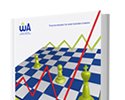Let’s do something different for a change. Let’s discuss tax planning at the beginning of the financial year rather than at the end. What is the point of the last minute mad rush each and every June? Also I prefer BOFY (Beginning of Financial Year) to EOFY, it has a nicer ring to it.
There are an untold number of deductions and ideas to legally reduce ones final tax liability. They vary according to the tax entity we are talking about (private individual, company, trust, SMSF etc.) or ones stage of life and employment e.g. young and working vs older and retired. Here are my BOFY Big 4.
Salary Sacrifice
This is the mother of all tax savings. It is ground zero for anyone looking to manage their affairs in a tax effective manner. What is the point of looking for other forms of tax savings without first getting max value out of a salary sacrifice arrangement? Maybe the word sacrifice is putting people off. Come to think of it, it does sound like a pagan sacrifice ritual to Plutus, the God of Wealth. I think it needs a makeover, how about Salary Redesign or Salary Redistribution, maybe one of these will catch on. Anyway, let’s move onto the numbers.
If you earn $90,000 pa and “redirect” $10,000 into your super you will have changed the tax rate from 39% to 15% on $10,000. There are several ways to look at this:
• You have saved 24% or $2,400
• Instead of ending up with $6,100 in your hands you got $8,500 into your super
• Put another way you have $2,400 more than the $6,100 you would have had or you just achieved a $2,400 risk free return on $6,100. A 39% after tax risk free rate of return!
Ladies and gentleman, this is what we in the business call a no brainer.
There are some important points you need to remember:
1. This is a concessional contribution so you need to be mindful of the cap.
2. You will need your employer’s agreement to do it. Most will but it is at their discretion so don’t take it for granted.
3. It can only relate to future income. You cannot sacrifice income in arrears. An agreement has to be in place before you do it.
4. It reduces your taxable income and this will reduce the compulsory 9.5% employer contribution (SGC). Unless you agree with your employer that they maintain their SGC levels.
Offset Accounts
People don’t often think of Offset Accounts (OA) as tax effective devices, but anything that reduces non-deductable interest is a tax planning tool.
If you have a home loan that doesn’t have an OA attached to it, stop reading this piece and call the bank and ask them to attach an OA to your home loan. If they say that the product you have doesn’t allow for that, ask them what other loan they have that does. If they cannot help you then just move your home loan to another bank that offers a 100% “full” Offset Account. Here is why.
Let’s say that you have a $400,000 home loan and are paying 4.5% variable interest. You earn $100,000 pa which puts you in the 39% tax bracket. You have $40,000 of cash savings in a bank account earning 1.5% at best.
What is wrong with this picture?
1. You are paying 4.5% after tax and receiving 1.5% taxable. Not good.
2. Or framed another way, you need to earn 7.37% gross (to pay 4.5% net) earning 1.5% gross. That is a 5.87% swing against you and in favour of the bank and the tax office. On $40,000 that equals $2,348 “annual cost” to you. Or for the nerds out there, it is a negative arbitrage.
An OA linked to your loan means that the bank is effectively paying you 4.5% after tax interest while you pay the 4.5% after tax interest. You and the bank are square and the tax man gets out of the way.
Superannuation Spouse Contribution Tax Offset
That is certainly a mouthful, but what it simply means is that if you contribute up to $3,000 to the super account of a no or low income spouse (I don’t like “non-working spouse”, if you are at home running after two hell raisers, you are working!!) you will receive an 18% tax offset against your personal income tax.
I like this one a lot.
18% on $3,000 equals $540 after tax. If you are on the top rate of 49% at the moment you need to earn $1,059 to net $540. That equals a risk free pre-tax return of 35% on your $3,000. Doesn’t get much better that! It is another no brainer in my book.
Transition Pension Accounts
If you are 60 and working your super should be in pension mode. Let’s look at the maths of someone with $500,000 in an accumulation account that has just earned 7% over the last year, $35,000. In accumulation mode they would have paid 15% tax on those returns or $5,250. By switching to pension mode the tax on earnings drops to zero (the Holy Grail of tax rates) thus saving them $5,250 pa. Let’s assume they were going to work for another 5 years to 65, which is a total saving of $26,250.
The catch is that you need to draw a minimum amount from your new pension account of 4% pa or $20,000 pa. Tax on this pension is also zero. If you don’t need that money for living then you contribute it back into super as a non-concessional contribution (as always be mindful of caps).
It is the combination of Salary Sacrifice and Transition Pension Accounts that is termed a Transition to Retirement strategy.
Where things get interesting is for those between the ages of 55-59. Even though you can start a pension when you turn 55 (or more precisely when you have reached your Preservation Age), it doesn’t always make sense to do so. I fear that this is one of the more misunderstood aspects of Transition Pensions. If you have a high marginal tax rate and a high portion of your account as “Taxable Component”, then the tax saved within the pension could be easily outmatched by the tax you pay on the annual pension payment. This is certainly not a no brainer.
Let’s assume our earlier person was 56 on the top marginal tax rate and all of their super was Taxable Component. The tax on their pension payment equals 34% (49% less 15% rebate) or $6,800. They saved $5,250 within the pension only to pay $6,800 outside. What was the point of that?
In closing, don’t do anything just for the tax benefit. Most good investment and financial planning decisions should be about creating wealth, or saving for retirement, retiring debt and getting closer to this thing called Financial Independence. If you get some tax assistance and benefit along the way that is the cream on the cake.
Have a great 2016FY!
 |
Want More Tax Effective Strategies?
Get The FREE eBook – The Top 12 Super and Tax Strategies There are some things in life that can’t be avoided. In Australia that includes paying tax and investing in Super. However, as you’ll see from this eBook ‘Top 12 Super and Tax Strategies’ there are things that you can do to work smarter. Download the eBook +
|









